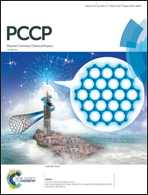Presence of Peierls pairing and absence of insulator-to-metal transition in VO2 (A): a structure–property relationship study
Abstract
Layered vanadium oxides have been extensively explored due to their interesting metal–insulator transitions and energy conversion/storage applications. In the present study, we have successfully synthesized VO2 (A) polymorph powder samples by a single-step hydrothermal synthesis process and consolidated them using spark plasma sintering. The structural and electronic properties of VO2 (A) are measured over a large temperature range from liquid helium, across the structural transition (400–440 K) and up to 500 K. The structural analysis around this transition reveals an antiferrodistorsive to partially ferrodistorsive ordering upon cooling. It is followed by a progressive antiferromagnetic spin pairing which fully settles at about 150 K. The transport measurements show that, in contrast to the rutile archetype VO2 (R/M1), the structural transition comes with a transition from semiconductor to band-type insulator. Under these circumstances, we propose a scenario with a high temperature antiferrodistorsive paramagnetic semiconducting phase, followed by an intermediate regime with a partially ferrodistorsive paramagnetic semiconducting phase, and finally a low temperature partially ferrodistorsive antiferromagnetic band insulator phase with a possible V–V Peierls-type pairing.



 Please wait while we load your content...
Please wait while we load your content...